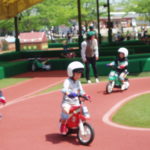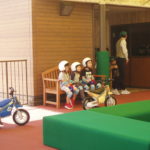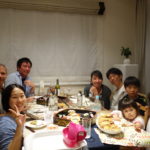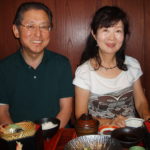Posts By Denver
Japan Visit April – May 2018
Thanks to my good friends in Japan including Kazunori and Fumiko, Tasuku and Emi; Masako,
as well as Katsu and Tomoko, I had a really enjoyable visit to the Tokyo area and Kanazawa.
Below are some of the photos from that visit.
Kanazawa
Denver with the Oda family at Twin Motegi Theme Park
I spent a family Sunday with Kazunori, Fumiko, Masatake and Mizuki at Twin Ring Motegi Racing Theme Park. It was a fine day weather-wise and we really enjoyed ourselves in spite of the large Golden Week crowds of people. I even found myself playing racing car driver with Masatake as co-driver. Certainly the first time I’ve ever been on a racing circuit! The drive through the Tochigi countryside was also really nice. Anyway, here are a few photos.
Italian Restaurant Yashio, Saitama with the Oda Family
Kamakura
The Bamboo Gardens
Tsujido Kanagawa
Delicious kushiage at an Izakaya
Endo, Kanagawa


watching an expert sushi chef!
Tsudijo Station Izakaya
with Emi and her family
With Tomoko and Katsunori
Lunch
Minka-en Folk Village
Pronunciation of Australian English 4
Sounds of Consonants Part 2 (the number in blue below is on the chart which I sent to you)
Generally these consonant sounds are more difficult for non-native English speakers and so they need a lot more practice.
Pronunciation of Australian English 3
Sounds of Consonants Part 1 (the number in blue below is on the chart which I sent to you)
Consonants are the third basic types of sounds in English. When consonant sounds are made, air coming from your mouth is partly or fully restricted (blocked).
Pronunciation of Australian English 1
Sounds of Vowels (the number in blue below is on the chart which I sent to you)
In English speaking, a vowel is a speech sound made with your mouth open and your tongue in the middle of your mouth not touching your teeth, lips or other inside parts.
Pronunciation of Australian English 2
Job Interview Tips for Japanese Seeking English Language Jobs
Behavioral Interviewing
Behavioral Interviewing is the most common Western business method of interviewing people for career appointments. The Behavioral method has been used for several decades, although recently there has been some criticisms about how suitable it still is in the modern world of business. I suspect most companies will still be using techniques based on behavioural interviewing for some years. So, the information below is largely based on this method.
General interview tips
-1. Ask questions from people already working in the company. Try and find out before the interview if they will use behavioural interviewing.
-2. First Impressions are very important. Smile, be relaxed as possible. Realise, it’s natural to be a bit nervous in a job interview. If you prepare well, it minimizes your nervous feelings at the interview. In modern behavioral interviewing, you need to show confidence that you are good at your job. Typical Asian job situations may expect you to be modest, but in behavioral interviewing you need to show confidently, “I am competent, I have performed well in this situation or at this activity in the past”.
-3. You prepare well by knowing as much as possible about the company; the job; the names and roles of the people who will interview you, and the main interview areas or aspects.
– 4. The main interview areas are: your skills; your achievements; your career ambitions; your knowledge; and your personality.
– 5. Perfect English? You don’t need to speak “perfect English”. Even native speakers show hesitation when speaking in interviews. People often make hesitating sounds like uhm , ahh, mmm. Just try to speak slowly and clearly.
– 6. Fillers. Instead of just making “uhm, ahh” sounds, try using “filler” speech. You can simply start by using words like ”well” , “right” or “so”. This is OK. Another good “filler” technique is to repeat the question by paraphrasing what the interviewer just asked you. Even better “filler” phrases include, “That’s a difficult situation; I’m glad you asked; Good question,” You can also use ASK questions yourself – e.g. “is that enough detail for you? Did I answer your question? So you mean that …..….?”
-7. Perfect fit? Many modern jobs (especially involving internet technology) are quite unique in their job description. So, few candidates may be a “perfect fit”. That is, don’t worry if you don’t have 100% of the qualities stated on the job description. But do try to mention any of your own skills, education or experience which are a match or similar to items on the job description.
-8. Practice saying what you plan to say in the interview many many times. Ask yourself the interview questions one by one, and then speak the answers ALOUD to yourself.
-9. KISS. Keep it simple stupid! Write mini stories which are consistent with your normal, natural English level.
-10. RELAX. The company has given you an interview. So, basically they think you are qualified for the job. They want to like you, so make it easy by being as relaxed as possible.
Competencies
Here is a list of “Desirable Behavior Qualities”, also called Competencies or Performance Skills. These are what most companies are looking for. Of course not all of these will be relevant to your specific job area. But you will need to show some of them when you create your job interview stories.
Adaptability
Communication-Oral (speaking)
Communication-Written
Control (self-discipline)
Analysis (looking at parameters)
Attention to Detail
Decisiveness
Delegation
Development of Subordinates
Energy
Entrepreneurial
Equipment and Software Operation
Insight
Flexibility
Impact
Independence
Initiative
Innovation
Integrity
Judgment
Leadership/Influence
Listening Skills
Motivation
Negotiation
Organizational
Sensitivity
Management
Planning and Organizing
Practical Learning
Presentation Skills
Rapport Building
Research Skills
Resilience
Risk Taking
Safety Awareness
Sales Ability/Persuasiveness
Sensitivity
Strategic Analysis
Teamwork
Technical/Professional Knowledge (theory)
Technical/Professional Proficiency (practice)
Technology savvy ( e.g. Skype, Twitter, FaceBook, Google, Microsoft Office)
Tenacity
Training
Work Standards
Planning your Interview
Plan your interview and be prepared to present yourself. Below are some questions and exercises that can also help you prepare:
What skills and contributions do you offer the company? (production and processes)
How can you “add value” to the company? (What is your value?)
What messages to the interviewers convey your skills and qualities? (conscious or subconscious)
What differentiates you from other applicants being interviewed for the same job?
GIVE EXAMPLES
Present yourself with concrete examples of your role and accomplishments.
What was your role, title, team type and position within the team?
Examples of how to do so:
“As Director of _____I….”
“I was responsible for…”
“As a member of the product team…”
“When I taught or instructed I…”
WHAT DID YOU DO?
“I created, led, initiated, designed, developed, simplified, organized, facilitated…”
Examples:
“I developed a plan that …”
“I created a process that…”
“I led the team that…”
RESULTS/OUTCOMES
What was the result of my efforts?
“I increased, improved, reduced, achieved…”
Examples:
“I reduced vacancy rates 30%”
“I improved test scores by 20%”
“I achieved highest-ever attendance levels”
“I increased call efficiency by 10% for 3 consecutive quarters.”
Our Departments sales, productivity improved by 15%
The project (event, presentation, report, etc.) was successful
People (the Chairman, the organiser, the client commented (praised me), congratulated me
I was commended for ….. recommended by …….., promoted to
These systems (procedures, people I trained) have been operating successfully for ….years now
COMMON BEHAVIORAL QUESTIONS
Here is a List of Common Behavioral Interview Questions
1. Can you please tell us a bit about yourself.
2. Describe a situation in your work career where you showed good leadership skills.
3. Describe how your interpersonal skills have been used effectively in your work situation.
4. Do you prefer to work alone or as part of a team?
5. Give an example from previous jobs of how you had a problem to solve. How did you go about solving the problem?
6. How do you respond to working under pressure?
7. What was your role in your department’s most recent success?
8. What do you see as your main strengths?
9. What do you see as your weak points?
10. Why do you want to work for our company?
11. What are your goals for the future?
12. What did you like most and least about your last job?
13. Do you have any questions to ask us?
Please realise these questions may be asked in different ways. You can paraphrase the question, that is, repeat the question to the interviewer in another way. For example, the interviewer may say,
“Tell me about a time when you were faced with problems or stresses at work that tested your coping skills.” This is the same as question 6 above.
You could reply, “ I guess you’d like to know how I respond to working under pressure?”.
The Interview should clarify, by saying “that’s right,” or another similar reply.
DO YOU HAVE ANY MORE QUESTIONS?
Send me a contact message. If you want to practice for a job interview, you can do that with me via my CafeTalk tutorial: Denver Finch, “New! Job! Interview! English for New Job Seekers”. Of course you can also access an astonishing amount of material on job searching and job interviewing via Google and Youtube. Some sources are great, others not so good. I recently discovered an excellent source of job interview information in Deniz Sasal, you can check him out at “thecareermastery.com” AND ALSO https://www.youtube.com/channel/UCN_zEeX1PVvk8kAQierYo3g
Some Features of Australian Society
Introduction
As with language, society is constantly changing. Also, it goes without saying, no country’s people are all identical in personality and behaviour. So, please note, the outline here is just a brief snapshot of Australian society.
Australian society used to be much more egalitarian, easy-going and casual. Traditionally, Australian society had probably 60% of people in the same class (working/ middle class). Increasing economic inequality over the past 50 years has shown itself by people more concerned about such things as high-earning occupations; large houses; fashionable clothes and fancy cars. However, most Australians still cling to “the idea” that we are all equal.
Business clothes (dress)
in general, although some people wear suits, many Australian people dress more casually for work than Japanese. Denim jeans is not so common, but other casual (but neat) pants and shirt (or skirt and blouse for women) is OK. At interviews, suits are most common.
Business meetings (visits)
We don`t have quite as many meetings and out of work dinners and parties as Japan. At a business lunch or dinner, business comes before the meal or drinking and socialising. Business cards are not normally exchanged upon first meeting. If you need a colleague’s contact information, it is ok to ask them for their card. It is also ok to offer someone your card. But there is not an elaborate ritual of exchanging cards
Demeanour
Australians (in general) are more assertive than English people and less assertive than Americans. Australians are certainly a bit more assertive and quicker to speak their opinions and disagree than Japanese. We also touch much more than Japanese and make eye contact more.
Dining (eating)
BYO (bring your own) alcohol and often food is still fairly common. At restaurants bill splitting (friends, couples, bigger groups)is also common.
Forms of Address
We don´t often call people Mr Smith, but rather Robert. We almost never call another adult “Sir” except in business letters. Some service people may address customers as “Sir or Madam”.
Gestures and body language
Australians use typical Western gestures for things such as “Come here, go away, stop, pointing, shaking hands”. Many of these are quite different to Japanese versions.
Giving Gifts
We only usually give presents on Xmas, weddings and birthdays. Most people try to give fairly modest, inexpensive gifts. We seldom give gifts to people we have just met.
Holidays
Most workers get 4 weeks paid holiday. There is also a few days leave for sickness or special events. School teachers get 8 weeks holiday. (but they deserve it!)
Noises
Australians will accept much more noise from neighbours than do Japanese.
Personal Space See Demeanour
Religion
In the past, Australian society has been very secular (like Japan) and certainly not as fundamental as many American religious people. For example, although most Australians say they are Christians, not so many go to church regularly. Recent conservative Australian governments show more leanings towards religious fundamentalism. For example, although the majority of Australian people are tolerant towards gay persons, the government refuses to consider legalizing same-sex marriages.
Smoking
This has become very socially unacceptable in the past 10 years. There are very few public places where you can smoke now.
Social visits
Much more than Japanese, we meet our friends at each others houses. In Japan, I got very few invitations to visit Japanese people at their home. Japanese seem to meet more at restaurants and Izakaya.
Stereotypes
Australians are friendly, easy going and not very formal. We regard workers as equal in status to bosses and address them equally.
Telephone Etiquette
similar to Japan I think.
Tipping
It´s not common practice to tip (taxis, waiters, etc.) in Australia.
Toilets
We say toilets, rather than bathrooms or rest-rooms.
We “have” a shower (or bath), we don`t “take” a shower. (unlike Americans)
Australian English
Australian English (a short introduction)
Some explanation of Australian English
Please keep in your mind that Australian language is changing (as language does in other countries). This is a result of great changes in society. As the society changes, so does the language. So, older Australian idioms and slang are not used so much by all Australians anymore. Also American slang such as “dude”, “cool”, “chill out” and “bling” have become common.
- Common old Australian slang words
mate friend
ta thank you
ta-ta bye bye, or see you
sanger a sandwich
banger a sausage
barbie barbecue
bewdy! great! [beauty]
footy Australian football
- A few common Australian words and phrases
The big smoke – This is what country people call the big cities.
The sticks – This is what city people call places in the country. (it means far away from the convenience of the city).
Don’t worry about it – it’s ok OR don’t take too much trouble.
Good on you – I like what you said or did.
Hang on – wait a minute.
BELOW ARE MORE EXAMPLES
A. Did you bring an umbrella?
B. No, I forgot.
A. Don`t worry about it, I have 2 umbrellas.
B. Good on you.
A.Can you help me?
B. Hang on, I`ll just answer my phone first.
A. Ok, I`ll wait.
“Don´t worry about it” (This is casual speech)
You say it if somebody apologises about something, e.g.
A. I´m sorry I´m late
B. Don´t worry about it.
If somebody thanks you e.g.
A. Thank´s for the lift.
B. Don´t worry about it.
(if you spill a drink, or bump into somebody)
“a lift” – a ride in somebody else´s car.
“do you mind?” e.g.
A. Do you mind giving me a lift into the city?
B. Sure, no worries.
(not a problem)
“Good on you” –
This is a sign of good feelings toward you.
Somebody may say this if you help them carry shopping groceries,
or if you open the door for them
or if you have been doing something good like hard study, or you have finished writing an essay.
- Common greetings
A bit formal –
A.Good morning/afternoon
B. Good morning/afternoon
A.How are you?
B. Fine thank you, and yourself?
A I`m well, thank you
A bit casual –
A.Good day, mate B. Good day.
A .How you going? B. Pretty good, and you?
A. I`m good.
Very casual –
A.Hi B. Hi
A. How are you? B. Not bad
A. What`s new? B. Nothing much.
A. Did you have a good weekend? B. Pretty good.
Talking About Baseball
Baseball is a sport made famous by the United States, but which is also extremely popular in East Asian countries including Japan and South Korea. Baseball, however, is not played or watched a lot in Europe, Africa, Australia, Russia or the Middle East.
Talking about Houses and Homes
In many ways modern living styles are much the same in Australia as they are in Japan. But there are some differences in the types of homes. Because the ratio of people to land space is much smaller in Australia, most people live in single storey houses on rather large blocks of land. High rise apartments are very much exceptional.




























